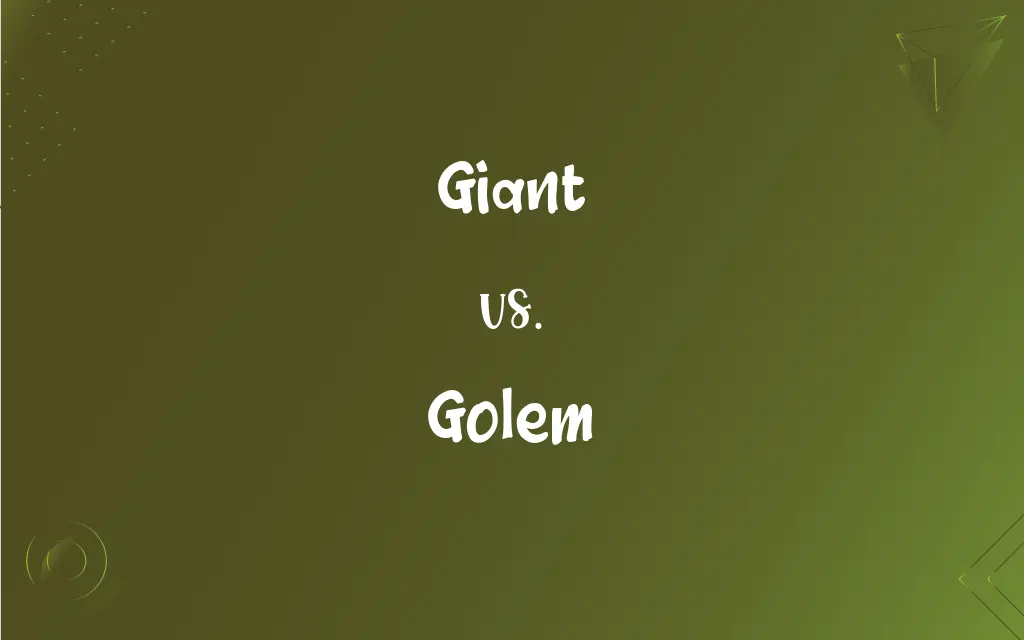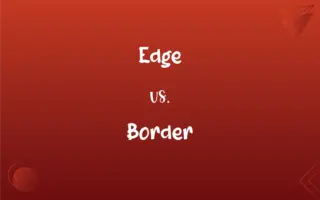Giant vs. Golem: What's the Difference?
Edited by Harlon Moss || By Janet White || Updated on October 7, 2023
A giant is a mythical being of human form but superhuman size, while a golem is a magical creature made of clay or mud, brought to life through ritualistic means.

Key Differences
Throughout folklore and mythology, the term giant has been used to describe beings of human appearance but of extraordinary size and strength. These beings often play significant roles in legends and fairy tales. On the other hand, a golem is rooted in Jewish folklore and is typically a creature animated from inanimate materials, commonly clay or mud, brought to life through mystical rituals.
Giants are often characterized by their enormous stature, and their tales span across various cultures, from the Norse Jotunn to the Greek Titans. Their narratives often involve interactions with gods or humans. In contrast, the golem legend primarily stems from Jewish tradition, where the creature is fashioned to serve or protect its creator but sometimes goes awry.
While giants in myths may have varied personalities, motives, and alignments - some benevolent and others malevolent - golems are typically devoid of free will or emotions. A golem follows the intent or instructions of its creator, acting more as a tool or servant than a character with personal desires.
The origin of giants varies across cultures: some are born, others are created by gods, and some have more ambiguous origins. Golems, however, have a more consistent origin story. They are crafted by humans and brought to life through sacred rituals, often involving inscriptions or commands written on paper and placed in their mouths.
In modern usage, giant can also refer to anything of unusually large size or to someone outstanding in a particular field. The term golem, while maintaining its traditional meaning, can metaphorically describe something that mindlessly follows orders or lacks independent thought.
ADVERTISEMENT
Comparison Chart
Origin
Various mythologies and cultures
Primarily Jewish folklore
Material
Typically flesh and bone
Usually clay or mud
Emotion/Will
Can have emotions and free will
Typically lacks emotions and free will
Role in Stories
Can be protagonists, antagonists, or neutral
Often created to serve or protect
Modern Interpretation
Can mean anything unusually large or an outstanding person
Can describe something that mindlessly follows orders
ADVERTISEMENT
Giant and Golem Definitions
Giant
A mythical being of human form but superhuman size.
The giant roamed the mountains, causing fear among the villagers.
Golem
A figure from Jewish folklore brought to life through ritual.
Legends of the golem are deeply rooted in Jewish tradition.
Giant
A person of exceptional talent or reputation.
Einstein was a giant in the world of physics.
Golem
A magically animated being created from clay or mud.
The rabbi fashioned a golem to protect the town.
Giant
An imaginary figure of superhuman size and strength.
Children love stories of giants and dragons.
Golem
A creature devoid of free will, following its creator's commands.
The golem obeyed every command, lacking any personal desires.
Giant
A person or thing of great size.
Golem
An entity created to serve a specific purpose.
The golem was made to guard the temple's treasures.
Giant
A person or thing of extraordinary power, significance, or importance
A giant in the field of physics.
Automotive industry giants.
Golem
A symbol of mindless labor or blind obedience.
The workers felt like golems, mindlessly following orders.
Giant
Greek Mythology One of a race of humanlike beings of enormous strength and stature who were destroyed in battle with the Olympians.
Golem
In Jewish folklore, an artificially created human supernaturally endowed with life.
Giant
A being in folklore or myth similar to one of these beings.
Golem
(mythology) A humanoid creature made from clay, animated by magic.
Giant
A gymnastic maneuver in which the body is swung, fully extended, around a horizontal bar.
Golem
A humanoid creature made from any previously inanimate matter, such as wood or stone, animated by magic.
Giant
Marked by exceptionally great size, magnitude, or power
A giant wave.
A giant impact.
Golem
(Jewish folklore) an artificially created human being that is given life by supernatural means
Giant
A mythical human of very great size.
Golem
A mechanism that can move automatically
Giant
(mythology) Specifically:
Giant
Any of the gigantes, the race of giants in the Greek mythology.
Giant
A jotun.
Giant
A very tall and large person.
Giant
A tall species of a particular animal or plant.
Giant
(astronomy) A star that is considerably more luminous than a main sequence star of the same temperature (e.g. red giant, blue giant).
Giant
(computing) An Ethernet packet that exceeds the medium's maximum packet size of 1,518 bytes.
Giant
A very large organisation.
The retail giant is set to acquire two more struggling high-street chains.
Giant
A person of extraordinary strength or powers, bodily or intellectual.
Giant
(gymnastics) A maneuver involving a full rotation around an axis while fully extended.
Giant
Very large.
Giant
A man of extraordinari bulk and stature.
Giants of mighty bone and bold emprise.
Giant
A person of extraordinary strength or powers, bodily or intellectual.
Giant
Any animal, plant, or thing, of extraordinary size or power.
Giant
Like a giant; extraordinary in size, strength, or power; as, giant brothers; a giant son.
Giant
Any creature of exceptional size
Giant
A person of exceptional importance and reputation
Giant
An unusually large enterprise;
Walton built a retail giant
Giant
A very large person; impressive in size or qualities
Giant
Someone or something that is abnormally large and powerful
Giant
An imaginary figure of superhuman size and strength; appears in folklore and fair tales
Giant
A very bright star of large diameter and low density (relative to the Sun)
Giant
Of great mass; huge and bulky;
A jumbo jet
Jumbo shrimp
Giant
A person or thing of unusually large size.
The redwood trees are giants of the forest.
Giant
An entity of considerable influence or importance.
The company is a giant in the tech industry.
FAQs
Are there female giants in myths?
Yes, myths feature both male and female giants.
Is a golem always made of clay?
Traditionally, a golem is made of clay or mud, but interpretations can vary.
Does a golem act on its own desires?
Typically, a golem lacks free will and follows its creator's commands.
What's the primary purpose of creating a golem?
A golem is often fashioned to serve or protect its creator or community.
Can a golem be destroyed?
In most tales, a golem can be deactivated or destroyed by removing its animating inscription.
Can a giant have emotions?
Yes, giants in myths can have varied personalities and emotions.
Who usually creates a golem?
A golem is often created by a learned person, like a rabbi, in Jewish folklore.
Can the term giant refer to non-living things?
Yes, giant can describe anything unusually large, like a "giant tree."
What's the primary cultural origin of the giant?
Giants appear in multiple cultures, from Norse to Greek mythology.
Is the golem legend well-known outside Jewish tradition?
Yes, the golem legend has permeated global pop culture and literature.
Do giants have any vulnerabilities?
Depending on the myth, giants can have specific weaknesses or vulnerabilities.
Are there real-world animals named after giants?
Yes, certain species like the giant squid derive their names from the term.
Are there giant deities in religions?
Some ancient religions feature giant gods or demigods in their pantheons.
Can a golem have human-like features?
Typically, a golem resembles a human, as it's often molded from clay in human form.
Is the term giant used metaphorically?
Yes, giant can metaphorically describe someone outstanding in a particular field.
Is the concept of golem used in modern entertainment?
Yes, the golem concept appears in books, films, and games, sometimes with variations.
Are giants always antagonistic in stories?
No, giants can be protagonists, antagonists, or neutral in tales.
Are giants and golems unique to specific geographies?
While giants appear globally, the golem legend primarily originates from Jewish European traditions.
Can both giants and golems be viewed as symbols?
Yes, giants can symbolize immense challenges, while golems can symbolize blind obedience or creation gone awry.
Is the golem always a protector?
While often created for protection, a golem can sometimes become uncontrollable or harmful.
About Author
Written by
Janet WhiteJanet White has been an esteemed writer and blogger for Difference Wiki. Holding a Master's degree in Science and Medical Journalism from the prestigious Boston University, she has consistently demonstrated her expertise and passion for her field. When she's not immersed in her work, Janet relishes her time exercising, delving into a good book, and cherishing moments with friends and family.
Edited by
Harlon MossHarlon is a seasoned quality moderator and accomplished content writer for Difference Wiki. An alumnus of the prestigious University of California, he earned his degree in Computer Science. Leveraging his academic background, Harlon brings a meticulous and informed perspective to his work, ensuring content accuracy and excellence.































































